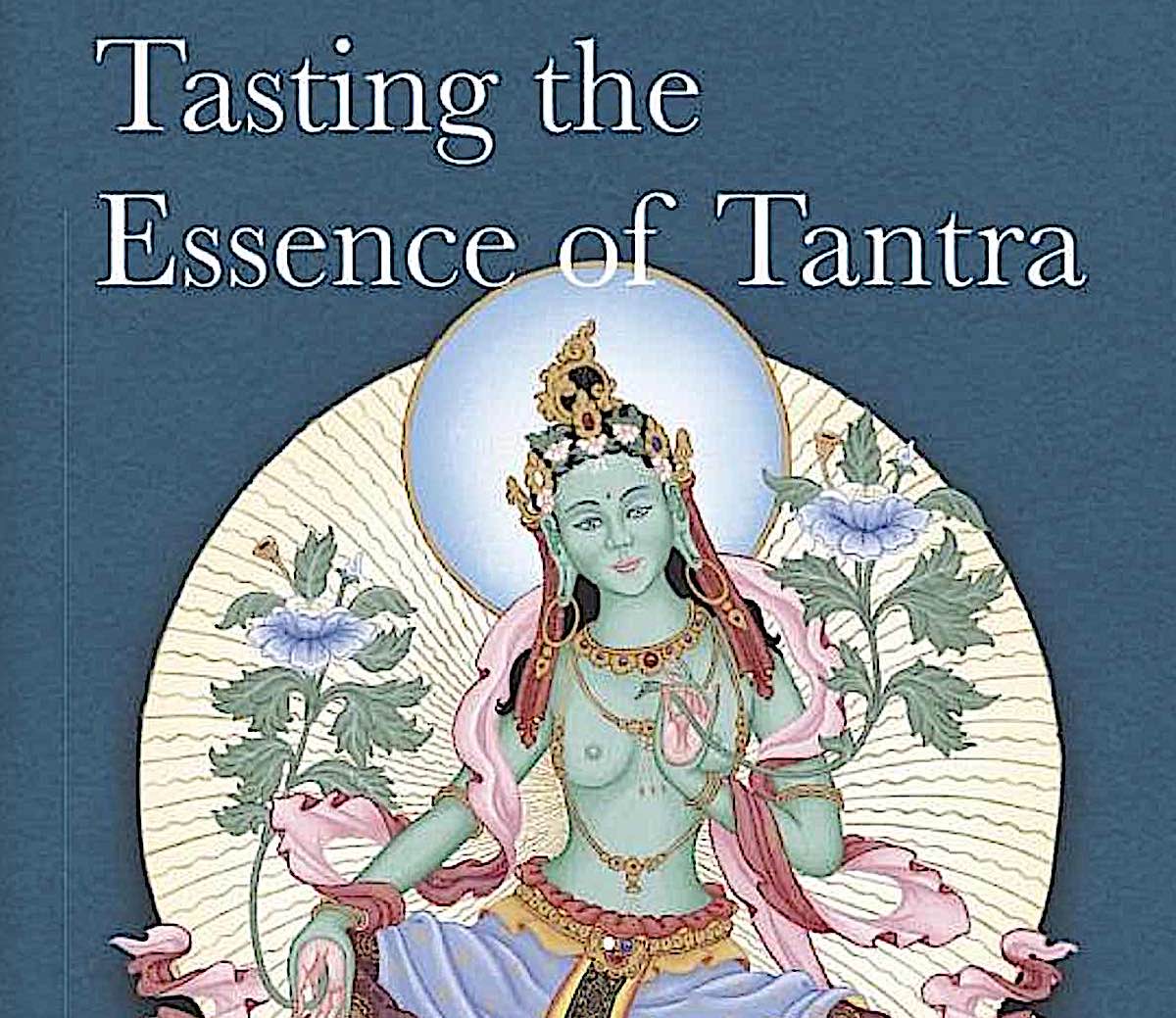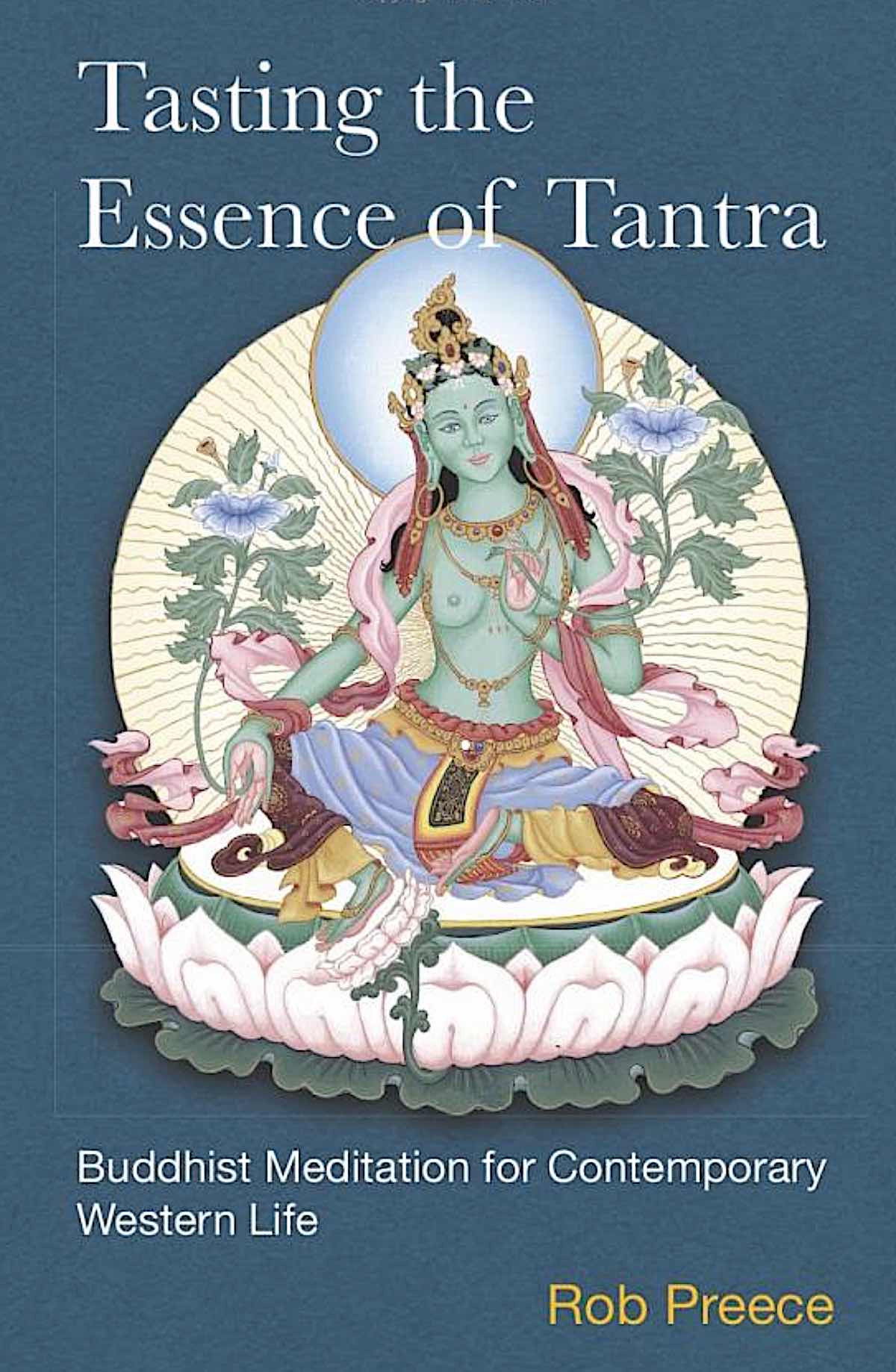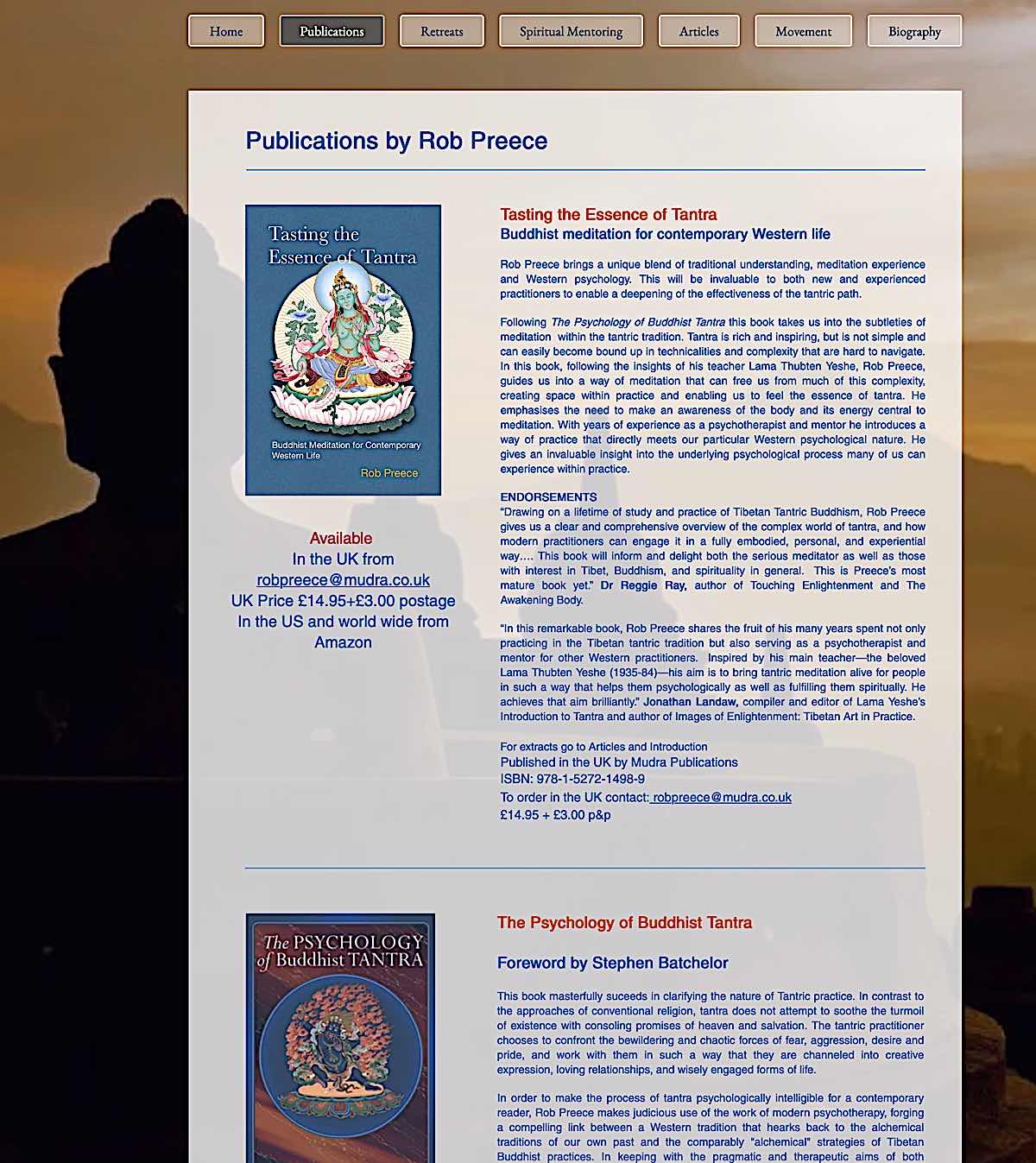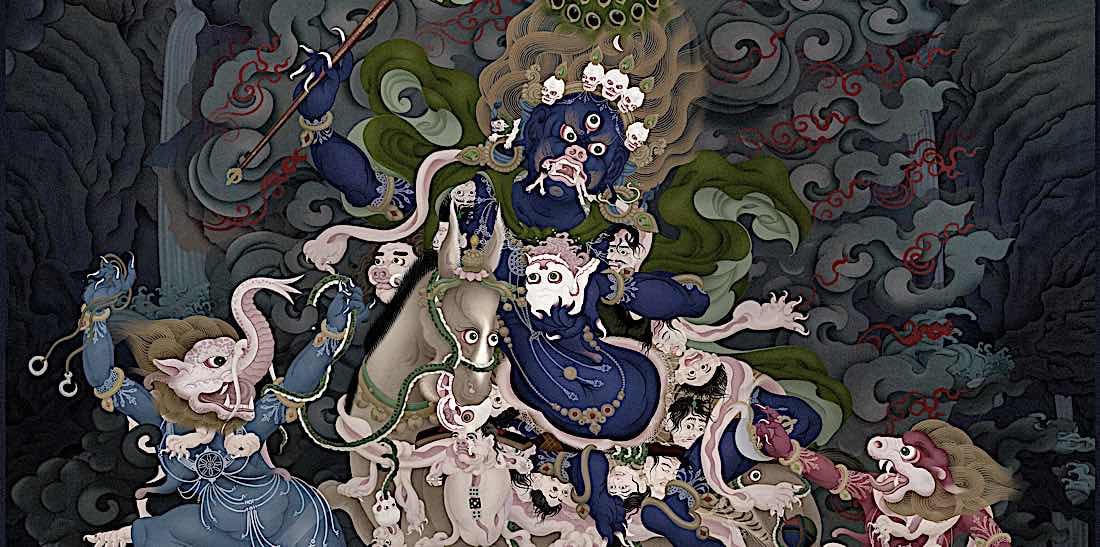Book Review: Tasting the Essence of Tantra: Buddhist Meditation for Contemporary Western Life by Rob Preece — Highly Recommended
Author-Psychotherapist Rob Preece’s excellent books have become go-to references for Western Buddhist teachers and students of Tibetan Buddhism. “The Psychology of Buddhist Tantra” was an instant classic, jammed full of thoughtful nuggets that help Western practitioners pierce the mystery...

Author-Psychotherapist Rob Preece’s excellent books have become go-to references for Western Buddhist teachers and students of Tibetan Buddhism. “The Psychology of Buddhist Tantra” was an instant classic, jammed full of thoughtful nuggets that help Western practitioners pierce the mystery of Buddhist Tantra. His other books include another favorite for modern Buddhists, Preparing for Tantra: Creating the Psychological Ground for Practice. We have quoted both extensively in past features. Rob Preece’s grasp of esoteric Tantra — and his ability to make it relatable in modern terms is legendary.
As thorough as these two texts are, we are thrilled to review his newest book, Tasting the Essence of Tantra: Buddhist Meditation for Contemporary Life — which takes practitioners deeper into the true subtleties of Buddha Tantra, and has especially helpful insights on practices such as self-generation, sadhanas and, my favorite concept from the book, “the deity as a window.”
Although it would be an exaggeration to claim his new book “simplifies” the vastly complex practices of Vajrayana — that might be an impossible task for any author — there is no doubt that most readers will be inspired by Preece’s presentation, and come away both wiser and more empowered, regardless of their practice base. His concepts should certainly bring clarity and motivation to anyone’s practice.
 Book cover of Tasting the Essence of Tantra by Rob Preece — an important book for practicing Vajrayana Buddhists.
Book cover of Tasting the Essence of Tantra by Rob Preece — an important book for practicing Vajrayana Buddhists.
Our rating
“Highly Recommended” for practicing Western Vajrayana Buddhists — 5 out of 5 — a clear, concise yet complete guide for busy lay practitioners of Tantric Buddhism.
“Strongly Recommended” for the “curious” about Vajrayana Buddhism — 4.5 out of 5 — although Preece makes everything “clear” the topics do dive deep into the ocean of practice.
Details
Tasting the Essence of Tantra: Buddhist meditation for contemporary Western life
Published in the UK by Mudra Publications
ISBN: 978-1-5272-1498-9
From Amazon.com (affiliate link)>>
Publisher : Mudra Publications (December 9, 2018)
Language : English
Paperback : 261 pages
ISBN-10 : 1527214982
ISBN-13 : 978-1527214989
Western Psychology and Buddhism?
How well do psychotherapy and Buddhism mesh? Regardless of tradition, it’s fair to say that all Buddha’s teachings — from Sutra to Tantra — have solid psychological foundations. The “poisons” of Buddhism, and especially hate/anger, greed, and ignorance are also concerns in modern psychology, at least it would seem so from this particularly inciteful book by working psychotherapist Rob Preece — who was also a student of Lama Thubten Yeshe and Lama Zopa Rinpoche.
Rob Preece makes it clear that there is a solid psychological ground to Buddhism when he enhances the “ordinary” definition of renunciation with a more tantric concept of “definite emergence”[1]:
“Renunciation in one sense is seeing that these things are not ultimately satisfactory and cannot bring true lasting happiness. It is not the things of our life that are the problem, however, but our relationship to them and the attachment that arises.”
The foundation of Tantra: Definitive Emergence
This is where the elegant logic of Preece’s book weaves a tapestry of logic that embraces tantric principles: “Definite emergence is the willingness to wake up, face our habit patterns and live our lives consciously and courageously, taking responsibility for our journey. Renunciation tends to suggest giving up or avoiding attachment to things that pull us into more confusion and unconsciousness. Definite emergence on the other hand is to engage fully with life, but with an awareness that faces what we are doing.
“The foundation of tantric practice is definite emergence, where we are willing to wake up to our habits and emotional motives.”
Bodhichitta threads
Preece’s elegant narrative then leads us to “the next level of intention, which is that we do not engage in this path with a view that is interested in just our own happiness or salvation. While the practice of tantra will undoubtedly bring a great sense of inner peace and happiness for oneself, we need to be broader in our intention than just our own personal interest. The second important quality of the tantric practitioner is therefore, the growing experience of what is called bodhichitta or the awakening mind. This could be described as the aspiration to awaken to our innate potential for the welfare of others.”
In modern terms, he points out how the two on entwined. He points out with clarity that with Bodhichitta we can embrace our inter-dependence [2]:
“To make this life meaningful we begin to see how we can use it for the welfare of others and of the planet that supports us. From a place of compassion and loving kindness towards all those around us we can then consider what would be of greatest benefit.”
This, of course, is a broader Mahayana understanding, but Preece continues to deftly weave the tapestry of tantra:
“In tantric practice we recognise that our innate nature is essentially pure, clear and spacious. When awakened, we see that the qualities this brings will be of great benefit in our relationship to others. If we can actualise some experience of this extraordinary inner potential then our lives and our ability to serve others will change radically. We can see this in the example of those who have awakened this innate potential like H.H. Dalai Lama. Bodhichitta, the awakening mind, is the willingness to dedicate our life to the service of others and to gradually awaken our innate buddha potential to do so.”
These quick passages give a sense of the depth of this book. These are quotes from the first two pages of this eloquent and insightful book. From here, Preece dives deep into the pristine “clear and spacious” waters of Tantra.
Before we finish the first chapter, we’ve already had taste of why Bodhicitta has another layer of meaning in the context of meditational deities and its relationship to our own Buddha potential. He cites the Heruka tantra here, and concludes with:
“This sense of surrender to the Buddhas is an opening in the present moment to be a vessel or vehicle to manifest in the world. Bodhichitta is like stepping into the flow of a river that is taking us to the ocean of enlightenment whether we will it or not.”
This notion of the “fluid empty nature of appearances” is, of course, a key concept in Preece’s book. The idea of “surrendering” and especially surrendering ego is also a driving theme in the book — as it is in Vajrayana practices.
Deities as a Window
I especially relate to Preece’s analogy of “deities as window” — the topic of chapter 10. Why window? As Preece explains [4],
“When we visualise a deity, it is as though we are looking into that window beyond which is the vast sphere of clarity and emptiness. If we can open to this awareness we will begin to awaken that wisdom in our nature and receive the blessing that comes through.”
Deities are certainly the most “controversial” aspect of Vajrayana, especially from the point of view of Sutra teachings. He confronts that immediately in this chapter [3]:
“I recall many years ago in Bodhgaya, India, hearing H.H.Dalai Lama respond to a question from a group of Westerners. Someone asked, what is the point of visualizing a deity? His answer was interesting and, I am sure, was particularly in response to this group which contained many people from the Theravada tradition. He said that when our mind is aware of the relative appearances of our reality, it is not able to be aware of emptiness. Then when our mind is aware of emptiness in meditation it is not able to cognize relative appearances. When we visualize ourselves as a deity, however, we are able to be aware of the form of the deity and emptiness at the same time. The mind can hold or cognize these paradoxical natures simultaneously; emptiness and appearance. One way that we can understand the significance of this is to recognise that a deity inhabits a realm that is metaphorically on the threshold between two dimensions of reality. Sitting on this threshold it acts as a kind of portal or gateway to another view of reality.”
Of course, he dives into the popular topic of duality: relative truth and ultimate truth and so on, but his correlations, anecdotes and insights are priceless. He makes a correlation between deity practice and what Carl Jung called “numinosity.” There is so much to love in this chapter, you’ll go back time and again and reread it.
Subtle energies and Sadhanas
As a reviewer, I particularly enjoyed Preece’s discussions on working with subtle energies, the deity as a window, and the sadhana. If you read no other chapters, you’d have your money’s worth from this superb book. For those new to Vajrayana, they might quickly thumb through to the chapters on “initiation” or “front generation” or “self-generation” — since these are topics that can be highly confusing to some Buddhists. Useful even outside of the Vajrayana context is the discussion on “Death and Transformation” and “Personal Practice.” For people looking for a modern take on tantra, definitely look to the chapter “A Psychological Process.” I could go on. Every chapter is important, useful and well-presented.
Initiation — Inspiration
A clear example of depth — and a topic many writers try to avoid — is Initiation. He begins with the standard metaphors of “seed” but dives much deeper. He returns to his gateway theme, but here it’s the opening of a window[5]:
“When we receive an initiation or empowerment something extraordinary can happen. The energetic field created in this process by the initiating lama can open us to an experience of the deity that affects us deeply. What the process of initiation does is to open the window I have spoken of in the previous chapter. The feeling of inspiration and awe we may then feel in the presence of the deity can be very powerful. Lama Yeshe used to say that we can experience significant realisation at the time of initiation if we are well prepared and open to receive the experience.”
But — he continues his presentation by discussing the difficulties that can arise, for example [6]:
“Over the years I have seen that difficulties can arise when we embark upon the process of receiving empowerments, particularly in relation to higher tantra (Skt: maha anutara yoga tantra). I experienced some of these myself in my early years as a Tibetan Buddhist and think it may be useful to name them. There is often a feeling that an initiation is a rare and important event that should not be missed. This can lead to a subtle pressure to take something that we may or may not be prepared for. It is easy for many of us to naively receive empowerments and not actually know what we are doing. What especially concerns me is that often only cursory guidance is given beforehand as to the complexity of what is being entered into. As a consequence, we may have little understanding of what is going on during an empowerment, in part because much of it is in Tibetan.
Fortunately, he doesn’t leave this as an unresolved issue. He frankly discusses and provides helpful advice. Later, in his discussion on commitments and samaya he explains how it can seem overwhelming, but also how many teachers of Western students are guiding these commitments [6]:
“This problem becomes especially acute when we are expected to fulfil commitments to many deities that require the recitation of sadhanas. This can be very time consuming and easily become dry and mechanical… Many or most Western practitioners are lay and have relatively conventional working lives which can often make it difficult to create space to practise. At its most detrimental I have known people suffer a huge sense of guilt and anxiety because they are not fulfilling something they have been told to do. If we come to the point of realising we are involved in something we simply cannot fulfil it can bring great inner conflict…”
Many students are probably familiar with this — I know I have felt this myself. Preece goes on to offer some rather “soothing” solutions, starting with His Holiness the Dalai Lama[8]:
“Fortunately, there are lamas who hold a somewhat more compassionate and less rigid view. H.H. Dalai Lama is one such teacher. When a friend found she simply could not relate to or do a particular higher tantra practice she had received some years earlier his advice was very sensitive. He told her to respectfully take the text of the practice, wrap it in cloth and place it on a shelf with the wish or prayer that at some time she may be able to practise it… What felt so powerful about the Dalai Lama’s response was that he is giving the message that we should not turn these guidelines for practice into a rigid dogma based on fear.”
Depth of the ocean — and this book
These are only snippets of a very deep ocean of wisdom and insight. The depths in this relatable presentation of Buddha Tantra is apparent from a quick glance at the chapter topics. Any, and all of them certainly are enlightening and deep — yet with relatable clarity. Part 1 alone is a full practice manual.
1 – Preparations for Practice
2 – Levels of Practice
3 – The Essence of Tantra
4 – The Challenge of Our Time
5 – Bridge to the West
6 – Discovering the Body as the Vessel
7 – Working with Subtle Energy
8 – Meditation in the Nature of Mind
9 – A Psychological Process
10 – The Deity as a Window
11 – Initiation
12 – The Sadhana
13 – Front Generation
14 – Guru Yoga
15 – Self-Generation
16 – Embodiment.
In part two, Preece dives deep (pun intended) into the transformative aspects of practice. He appropriately labels this “A Journey of Depth.” Don’t miss the chapter “The Gods in our Diseases.”
17 – Levels of Consciousness
18 – Meeting the Unconscious
19 – The Gods in our Diseases
20 – The Journey of Descent
21 – Death and Transformation
22 – Re-emergence into Form
That seems fairly complete, but part three continues with the practical guidance:
23 – Personal Practice
24 – The Role of Mentors
25 – Devotion with Discernment
Epilogue: Going Forward.
 Book page on Mudra’s website.
Book page on Mudra’s website.
This is the first in a 6-book series
Books one and two are now published. This one, I’ll call “book one.” The Second we will soon review, titled “The Mandala and Visions of Wholeness: Within Tibetan Buddhism and Jungian Psychology.
The remaining books all sound fascinating and helpful. We will certainly review them when they are available:
Heart Essence: Enhancing Qualities of the Awakened Mind Manjushri: The Creative Expression of Wisdom Chenrezig: Embodying Compassionate Presence Vajrapani: Clarifying our Relationship to Power Green Tara: Embodying Dynamic Compassion.You can learn more about these books, Rob Preece, articles, retreats and mentoring at www.mudra.co.uk
Past bibliography of Rob Preece
Feeling Wisdom
Working with emotions using Buddhist teachings and Western psychology
Published in the US by Shambala Publications
ISBN : 978-1611801682
From Amazon.com (affiliate link)>>
Preparing for Tantra
Creating the Psychological Ground for Practice
Published in the US by Shambala Publications
ISBN 9781559393775
From Amazon.com (affiliate link)>>
The Courage to feel
Buddhist practices for opening to others
Published in the US by Shambala Publications
ISBN-10: 1-55939-333-5
From Amazon.com (affiliate link)>>
The Wisdom of Imperfection
The challenge of individuation in Buddhist life
Published in the US by Shambala Publications
ISBN 1-55939-252-5
From Amazon.com (affiliate link)>>
The Psychology of Buddhist Tantra
Published in the US by Shambala Publications
ISBN -10 1-55939-263-0
From Amazon.com (affiliate link)>>
Tasting the Essence of Tantra
Buddhist meditation for contemporary Western life
Published in the UK by Mudra Publications
ISBN: 978-1-5272-1498-9
From Amazon.com (affiliate link)>>
The Mandala and Visions of Wholeness:
Within Tibetan Buddhism and Jungian Psychology
Published in the UK by Mudra Publications
ISBN: 978-1739940201
From Amazon.com (affiliate link)>>
Heart Essence
Enhancing Qualities of the Awakening Mind
Published in the UK by Mudra Publications
ASIN : B0B54VYBWW
From Amazon.com (affiliate link)>>
 Author Rob Preece.
Author Rob Preece.
Rob Preece’s Bio (from the website)
ROB PREECE (BSc. Adv. Dip. Transpersonal Psychology UKCP reg.)
Following a 4 year apprenticeship in electronics engineering Rob went to university to study psychology. It was at this time he met both the work of C.G. Jung and Buddhism. In 1973 after a period of travel he met met Lama Thubten Yeshe and Lama Zopa Rinpoche in Nepal. Since that time he has been a practicing Tibetan Buddhist.
After working as a social worker Rob was part of a small group that founded a Buddhist centre in the UK for his Tibetan teachers. For the next four years he studied the foundations of Tibetan practice in that Buddhist community. In 1980 he returned to India and was in retreat for much of the next five years. This gave him a chance to explore the practices of the Tantric tradition in some depth meditating under the guidance of Lama Yeshe, Zopa Rinpoche and Gen Jhampa Wangdu in particular. While in India he was fortunate enough to receive teachings on many of the important aspects of Tibetan Buddhism, in particular Tantric teachings, from Lamas such as H.H. Dalai Lama, Song Rinpoche and many others. It also gave him the opportunity to learn Tangkha (Tantric Icons) painting.
Returning to the west he at first lived as a Tangkha painter and then in 1985 he trained as a psychotherapist principally with the Center for Transpersonal Psychology. This began the process of bringing together the two worlds of Buddhism and Western psychology. He has been a practicing psychotherapist since 1988 gradually developing a style that is a synthesis of Buddhist and Jungian understanding.
Since 1985 he has been leading meditation retreats following the instruction and guidance of his teachers. Lama Yeshe was particularly influential is this, supporting his integration of a more Western approach. This has meant gradually guiding people through a kind of apprenticeship in the practice of Tantra. Rob’s one-to-one work is now principally spiritual mentoring bringing together his experience of both Eastern and Western approaches.
He is the author of many books bridging the Tibetan tradition with Western psychology intended to support Buddhist practice in contemporary life. These include The psychology of Buddhist Tantra; The Wisdom of Imperfection; The courage to Feel; Preparing for Tantra; Feeling Wisdom and Tasting the Essence of Tantra.
Rob leads many meditation retreats in the UK some of which incorporate a movement practice facilitated by Anna. He also teaches in Europe and the US. As a father of two sons, an experienced Tangkha painter and a keen gardener he tries to ground Buddhist practice in a creative practical lifestyle.
NOTES
[1] Preece, Rob. Tasting the Essence of Tantra: Buddhist Meditation for Contemporary Western Life (Essence of Tantra Series) (p. 20-21). Mudra. Kindle Edition.
[2] Preece, Rob. Tasting the Essence of Tantra: Buddhist Meditation for Contemporary Western Life (Essence of Tantra Series) (p. 21). Mudra. Kindle Edition.
[3] Preece, Rob. Tasting the Essence of Tantra: Buddhist Meditation for Contemporary Western Life (Essence of Tantra Series) (pp. 89-90). Mudra. Kindle Edition.
One of the aspects
[4] Preece, Rob. Tasting the Essence of Tantra: Buddhist Meditation for Contemporary Western Life (Essence of Tantra Series) (p. 92). Mudra. Kindle Edition.
[5] Preece, Rob. Tasting the Essence of Tantra: Buddhist Meditation for Contemporary Western Life (Essence of Tantra Series) (p. 96). Mudra. Kindle Edition.
[6] Preece, Rob. Tasting the Essence of Tantra: Buddhist Meditation for Contemporary Western Life (Essence of Tantra Series) (p. 97). Mudra. Kindle Edition.
[7] Preece, Rob. Tasting the Essence of Tantra: Buddhist Meditation for Contemporary Western Life (Essence of Tantra Series) (pp. 98-99). Mudra. Kindle Edition.
[8] Preece, Rob. Tasting the Essence of Tantra: Buddhist Meditation for Contemporary Western Life (Essence of Tantra Series) (p. 99). Mudra. Kindle Edition.

 UsenB
UsenB 


























![Is Your SEO Strategy Built for the AI Era? [Webinar] via @sejournal, @hethr_campbell](https://www.searchenginejournal.com/wp-content/uploads/2025/07/6b-240.png)





